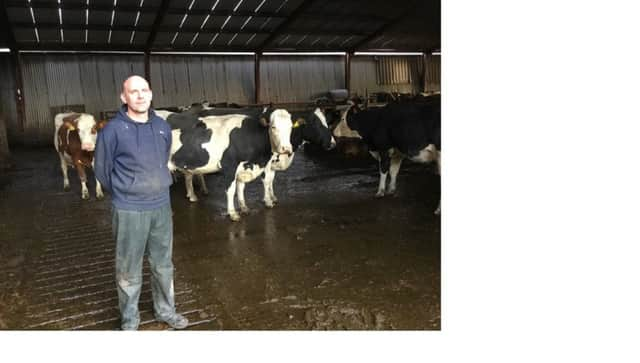Using Dairy Herd Management to reduce antibiotics


The 125-cow herd has just recently passed the one million litres of milk milestone, something he has been targeting to achieve.
However, the focus on this farm is far from solely litres of milk produced. Mark is keen to improve milk solids and already boasts healthy figures of up to 4.3% butterfat and 3.4% protein. He has achieved this through good nutrition but also through introducing different genetics. For a number of years, he had crossed Montbeliarde bulls on his Holstein cow base but due to the large size of the cows he has now reverted to a three way cross involving Holstein, Viking Red and Jersey with all cows bred by AI and heats identified by an electronic heat detection system. This cross-breeding approach suits the system Mark is trying to achieve as he is comfortable with an average yield around 8,000 litres.
Advertisement
Advertisement
The farm very much takes a holistic approach to cow health with Mark keen to reduce antibiotic use where possible. He milk records on a DIY basis with Dairy Herd Management with the SCC average for the herd running between 120 and 150. He finds the information provided invaluable as he uses the data to decide on which cows are suitable for teat sealants only, taking a cut off of under 200 for the last two recordings. He has been using this approach since teat sealants came into the market and had tremendous success. He now finds that only 15% of his cows need antibiotic treatment. Mark lists the advantages as firstly, cost saving, with the cost of dry cow antibiotic tubes running at £4.60 per cow and the cost of a Snap test to ensure her milk is suitable for the bulk tank at £2.75/cow. Secondly, the peace of mind of knowing that he won’t be risking an antibiotic failure as the cow hasn’t had any antibiotic therapy is invaluable, particularly if relief milkers are used. Finally, he believes the overall health of the cow is improved as she isn’t receiving drugs she doesn’t need, and the healthy bacteria still remain in the udder to fight off any infections.
Like anyone using teat sealants only, Mark is very particular around hygiene at drying off time. He reiterates that it’s not a job to be rushed and takes great attention to ensure he’s wearing clean gloves and that all teats are thoroughly cleaned before pinching the top of the teat and inserting the sealant into the teat canal. He also starts at the furthest away teats and works towards himself to ensure he doesn’t spread bacteria to the nearest ones.
The environment for the dry cows is also well managed with this farm bedding dry cows every day with lime and sawdust to prevent the build-up of bacteria in the cubicle beds. A dedicated dry cow silage is also grown which receives no fertiliser and is let grow out a bit longer to ensure more fibre which all helps to improve the consistency of the dung and assists in keeping cows cleaner. In recent years Mark has started feeding the dry cow silage in the evening and found he has reduced night calvings down to 15% which means he doesn’t miss too many calvings. This in turns means colostrum can be fed quicker to calves and where calving assistance is needed he’s more likely to be available.
The farm has always embraced preventative medicines where possible, with homeopathy used for several years to decrease the risk of mastitis and AHV boluses recently introduced to combat recently infected mastitis cases. As well as maximising cow health and nutrition, Mark has a thorough vaccination policy with cows vaccinated for BVD, IBR and Lepto. The risk of botulism and the subsequent huge financial loses have prompted him this year to cover cows for this disease as well, and in recent years he has opted to vaccinate the last 40 cows to calve with Rotavac as he often finds more problems at the end of the calving season.
Advertisement
Advertisement
Mark completed the MilkSure training course with his vet recently and found the course very useful. In particular, he learnt a lot about the effect of using multiple antibiotic treatments and how this leads to longer withdrawal periods, something he’d never considered much previously. He believes this is a course more farmers should consider undertaking and with Dale Farm offering a £100 incentive to those producers who voluntarily complete the course it can be done for very little cost.
It’s encouraging to see how this farm has embraced all facets of animal health and nutrition to allow cows to use their own immunity to fight infections while employing a thorough vaccination to policy to help reduce the chances of disease outbreaks. They also make full use of information systems such as Dairy Herd Management and electronic heat detection to assist with the management of this modern dairy herd. Ever willing to try to explore new opportunities to reduce antibiotic usage this farm is well set up to produce a clean healthy nutritious product for many years to come.
For more information about Dairy Herd Management please contact 028 9037 2099 or call David Patterson on 07900 248 073.